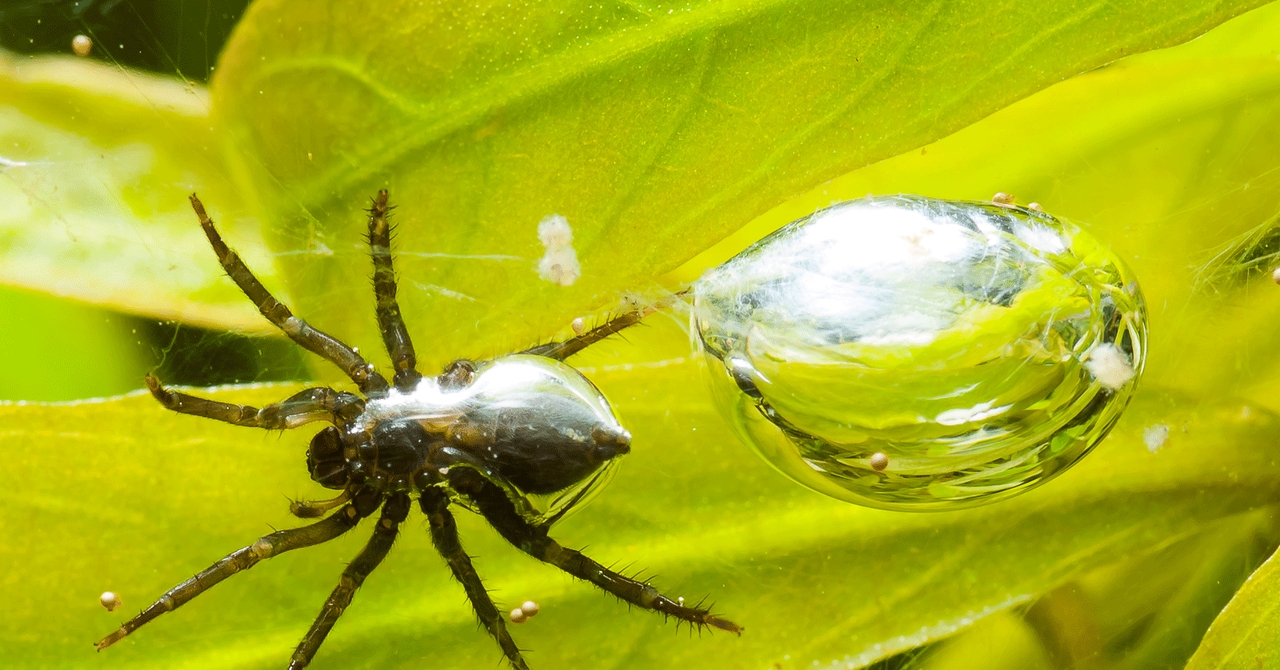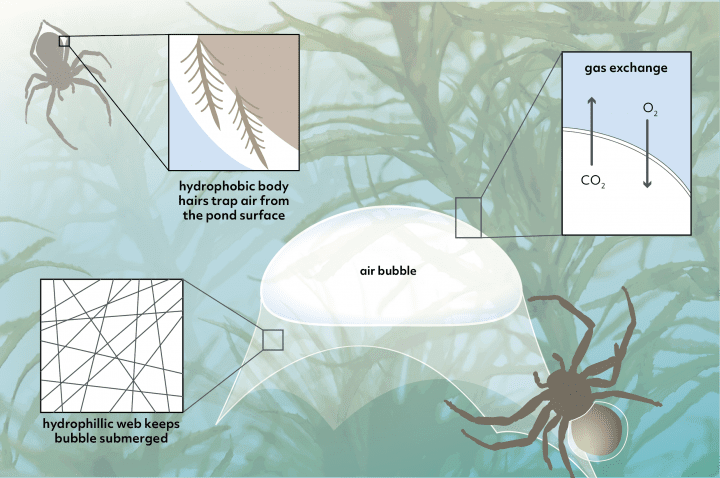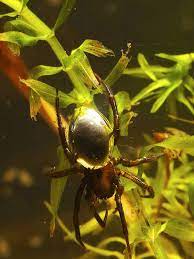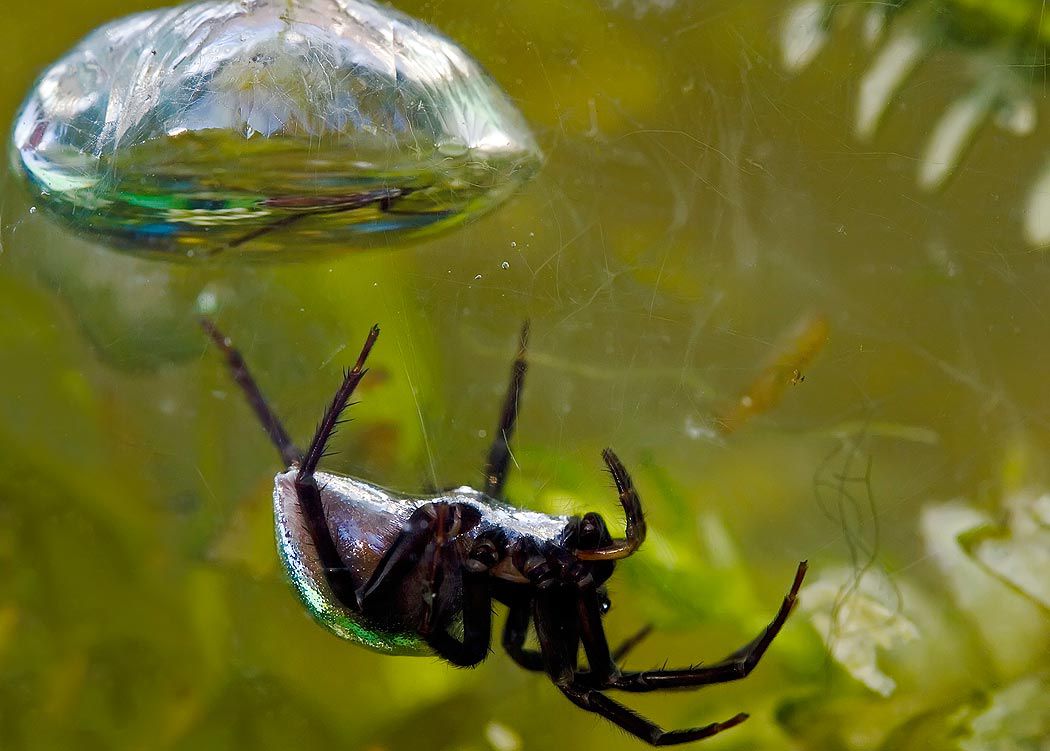Most spiders weave webs in open spaces to capture insects. When the Eurasian diving bell spider weaves a web, however, it’s in a dramatically different setting, with a dramatically different function. Stretched between parts of underwater plants, this spider’s web holds a spider-sized bubble of air beneath the surface of a pond. It serves as both home base and a literal breath of fresh air for its weaver.

A diving bell spider begins constructing its home under the surface of a pond or standing water in a wetland in much the same way land-living spiders build their webs: by extruding silken threads from spinnerets in its abdomen and fastening them to plants. It then moves back and forth between the anchors, first producing parallel strands and then crossing them with others. It lightly coats the threads with a protein-based goo it also produces from its body. Both the silk and the goo are hydrophilic, meaning they attract water. Together, they create a loosely woven sheet of spider material and water that traps air bubbles below instead of letting them rise to the surface.
The diving bell spider, or water spider, is the only species of spider known to live almost entirely under water. How does it reside under water?

Now it’s time to gather some air. The spider swims to the surface, sticks the back end of its abdomen up in the air, and spreads its rear legs. The abdomen is covered with tiny, feather-shaped water-repelling hairs set into small grooves. As the spider submerges, the hairs trap air in a glistening bubble, which is held in place with the help of the legs. The spider carries the bubble beneath the web and releases it. The bubble rises until it reaches the web, but the thread and goo combo prevents it from going any farther. The spider goes back for more until eventually it builds up an air chamber big enough to provide the oxygen it needs.
As the spider breathes inside its bubble home it uses up oxygen. That causes oxygen trapped in the water around it to diffuse into the bubble, replacing what the spider depleted. Similarly, the high concentration of exhaled carbon dioxide inside diffuses out of the bubble into the surrounding water. If the oxygen concentration declines more rapidly than diffusion can replenish, the spider simply returns to the surface to grab some more bubbles.
The diving bell spider’s ability to create an air supply beneath a silken web underwater offers a variety of inspirations for innovations that benefit humans. The spider’s ability to trap small amounts of air against its body using tiny, water-resistant hairs embedded in grooves offers insights that can be used to develop painted-on coatings for ships that hold tiny amounts of air. Such coatings could reduce rusting, make it harder for ship-degrading microorganisms to attach to the outside of a ship, and provide lubrication to reduce friction with the water and so make the ship more energy-efficient.
The ability to make an airspace that replenishes oxygen by drawing it from surrounding water could open the door to allowing humans to spend extended time in oceans, lakes, or rivers for scientific, commercial, or recreational pursuits. It could even provide a useful model for developing living spaces beneath the surface.
How Diving Bell Spiders Create Underwater Air Bubbles
Diving bell spiders, also known as water spiders, are fascinating creatures that have the unique ability to spend their entire lives underwater. These spiders have evolved a remarkable strategy to breathe underwater by constructing and using air bubbles, which they build and maintain as a vital source of oxygen. In this article, we will explore the intriguing mechanisms and behaviors that enable diving bell spiders to create and utilize these underwater air bubbles.

Understanding Diving Bell Spiders
The Life of a Diving Bell Spider
Diving bell spiders (Argyroneta aquatica) are the only known species of spider that live exclusively underwater. They are typically found in slow-moving freshwater habitats, such as ponds and wetlands. Unlike most spiders, which breathe air and build webs on land, diving bell spiders have adapted to an almost entirely aquatic lifestyle.
Physical Characteristics of Diving Bell Spiders
Diving bell spiders exhibit several unique physical adaptations that enable them to thrive in their underwater environment. These spiders have a sleek and streamlined body shape, which allows them to move through the water with ease. They also possess specialized hairs on their legs and abdomen that repel water, facilitating their ability to create and maintain air bubbles.
The Importance of Air for Diving Bell Spiders
Air is a vital resource for diving bell spiders, as it provides them with the necessary oxygen for respiration. While underwater, these spiders rely on the air bubbles they create to extract oxygen from the surrounding water. By developing and managing these air pockets, diving bell spiders have found a way to survive in an otherwise inhospitable environment.

Building the Underwater Air Bubble
Construction of the Air Bubble Web
To create their underwater air bubbles, diving bell spiders employ a unique construction method. Using their spinnerets, which are specialized silk-producing organs, the spiders extrude silken threads and attach them to aquatic plants or other submerged structures. By moving back and forth between these anchors, they gradually build a dome-shaped web that encloses an air bubble.
The Role of Silk and Goo
Diving bell spiders utilize a combination of silk and a protein-based goo to construct their air bubble webs. The silk and goo are both hydrophilic, meaning they attract water. When combined, they form a loosely woven sheet that traps air bubbles below the surface of the water. This structure prevents the air from escaping and allows the spiders to create a stable and breathable environment within the bubble.
Gathering Air from the Surface
Once the air bubble web is constructed, the diving bell spider needs to fill it with air. The spider swims to the water’s surface and exposes the back end of its abdomen, which is covered in water-repelling hairs. As the spider submerges, these hairs trap air in a glistening bubble, which is held in place with the help of its legs. The spider then carries the bubble back to the web and releases it, allowing it to rise and become trapped within the silk and goo structure.
Oxygen and Carbon Dioxide Exchange
The air bubble serves as a vital source of oxygen for the diving bell spider. As the spider breathes inside its bubble home, it consumes oxygen and produces carbon dioxide. However, the spider has developed a clever mechanism to maintain a fresh supply of oxygen. The high concentration of exhaled carbon dioxide inside the bubble diffuses out into the surrounding water, while oxygen from the water diffuses into the bubble, replenishing the spider’s oxygen stores.
Survival Strategies of Diving Bell Spiders
Living in the Air Bubble Nest
The air bubble web created by diving bell spiders serves as their primary habitat. Within this nest, the spiders can carry out essential activities such as mating, laying eggs, resting, and feeding. The bubble provides a protected space where the spiders can reside for extended periods, allowing them to remain submerged and avoid predation.
Managing Air Supply
Diving bell spiders have developed efficient strategies to ensure a constant supply of air within their nests. When the oxygen concentration within the bubble declines, the spider can return to the surface to gather more air bubbles. By repeating this process, the spider can maintain a sufficient oxygen level for its survival.
Adaptations to Underwater Life
Living exclusively underwater has necessitated various adaptations in diving bell spiders. For instance, their book lungs and tracheal system utilize the air trapped at the water’s surface by hydrophobic hairs on their abdomen and cephalothorax. Additionally, the spiders have evolved specialized behaviors and physiological mechanisms to thrive in their unique aquatic environment.
Potential Applications and Implications
Inspiration for Innovation
The ability of diving bell spiders to create and utilize underwater air bubbles has captivated scientists and researchers. This natural phenomenon has the potential to inspire innovations in various fields. For example, the spider’s mechanism of trapping air could be used to develop coatings for ships that hold small amounts of air, reducing rusting and improving energy efficiency.
Underwater Living Spaces
The diving bell spider’s strategy of building and residing in an air bubble nest could provide insights into the development of underwater habitats for human use. By understanding the spider’s physiology and behavior, researchers may be able to design structures that allow humans to live and work beneath the water’s surface for scientific, commercial, or recreational purposes.
Diving bell spiders are truly remarkable creatures that have adapted to live underwater by constructing and utilizing air bubbles. Through their intricate behaviors and physiological adaptations, these spiders have found a way to breathe and survive in an otherwise inhospitable environment. The study of diving bell spiders not only provides insights into the fascinating world of aquatic spiders but also offers potential applications and a deeper understanding of the delicate balance of life in freshwater ecosystems.
